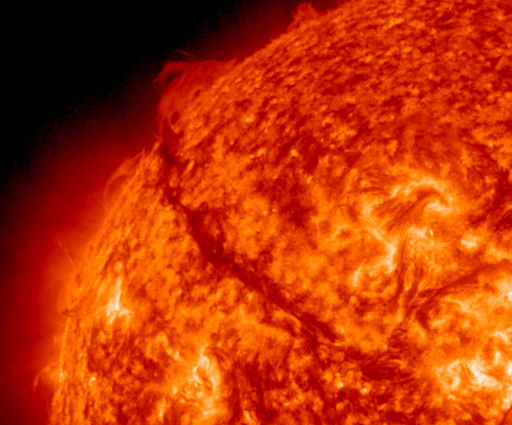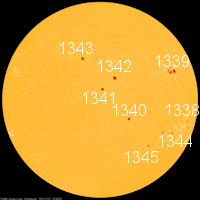11~12~11~SPACE WEATHER UPDATE~ CME IMPACT~
CME IMPACT: As predicted, a coronal mass ejection (CME) hit Earth's magnetic field on Nov. 12th at approximately 0600 UT. The impact was weak, however, so it is not yet clear whether the event will produce significant geomagnetic storms or auroras. Stay tuned for updates. Aurora alerts: text, voice.
GRAND FILAMENT: A filament of magnetism more than 700,000 km long is curling around the sun's northeastern limb. NASA's Solar Dynamics Observatory photographed the vast structure during the early hours of Nov. 12th:
The filament is weighted down by solar plasma. If it erupts--as such filaments are prone to do--it could fall to the stellar surface below, setting off an explosion called a Hyder flare. Or it might fly upward, hurling fragments of itself into space. Amateur astronomers with solar telescopes are encouraged to monitor the region for developments. The only challenge will be fitting the whole thing into a single field of view. Solar flare alerts: text, voice.
more images: from Lyrics Some of Shiqi, Panyu, Guangzhou, China; from John Nassr of Baguio, Philippines; from Alan Friedman of Buffalo, NY; from Ted Adachi of Montreal, Quebec, Canada
SKY COLORS: Auroras in Nebraska are rare, but who needs auroras when you've got iridescence? University of Nebraska freshman Evan Ludes took this picture of cloud-colors over Omaha on the morning of Nov. 10th:
"I walked out of class this morning and was greeted by one of the best iridescence displays I've ever seen!" says Ludes. "The colors formed on the leading edge of a long stretch of cirrocumulus clouds."
Iridescent colors appear when sunlight shines through water droplets in the edges of clouds. The mechanism is diffraction. The colors are at their brightest and most distinct when the droplets are small and uniformly-sized.
"I'm no optics expert," says Ludes, "but I'm guessing the colors were particularly vivid since these clouds were newly formed and therefore likely had water droplets of similar shape and size. It was incredible how distinct the bands of colors were even when zoomed in at 300mm!"

Solar wind
speed: 455.9 km/sec
density: 1.9 protons/cm3
explanation | more data
Updated: Today at 1436 UT
X-ray Solar Flares
6-hr max: C1 0801 UT Nov12
24-hr: C2 0751 UT Nov12
explanation | more data
Updated: Today at: 1400 UT
![]()
Daily Sun: 12 Nov 11
The decay of sunspot 1339 is accelerating, but it still poses a threat for M-class solar flares. Credit: SDO/HMI




